| This section describes the DC and AC characteristic of the differential transmitters and receivers. This includes impedance and voltage levels required for compliant operation of the differential transmitters and receivers. Differential DC Characteristics Figure 14-2 illustrates a differential link connection between a transmitter and receiver. The specification defines the impedance and subsequent voltages that will be developed under steady-state conditions (i.e., when transmitter is driving a differential 0 or 1). Figure 14-2. HT Link Differential Driver and Receiver  Differential DC Impedance The DC impedance parameters are defined in the following bullet list and illustrated in Figure 14-3 on page 368 and the impedance parameter values are listed in Table 14-3 on page 369. -
R TT is the differential input impedance under steady-state DC conditions (i.e., with a constant differential "1" or "0" driven). An on-die terminating resistor is used to adjust the receiver's input impedance to the required value. The receiver must have compensating circuitry that dynamically guarantees the impedance of the receiver stays in tolerance (see Table 14-3 on page 369) across the voltage and operating ranges of the device. -
R ON ” the driver output impedance under steady-state DC conditions. The driver must have compensating circuitry that dynamically guarantees the driver impedance remains within tolerance (see Table 14-3 on page 369) across the voltage and operating temperature ranges of the device. -
Delta-R ON (true) ” the difference in driver output impedance under DC conditions between R ON (on true side) when a differential 1 is driven and when a differential 0 is driven. [(R ON +) -(R ON -)]. -
Delta-R ON (complement) ” the difference in driver output impedance under DC conditions between R ON (on complement side) when a differential 1 is driven and when a differential 0 is driven. [(R ON +) -(R ON -)]. -
Z Line ” the impedance of the coupled transmission line. Notice that Z Line does not exactly match ½ R TT . This mismatch is intended to provide a slightly over-damped single-ended termination. Figure 14-3. DC Impedance Values 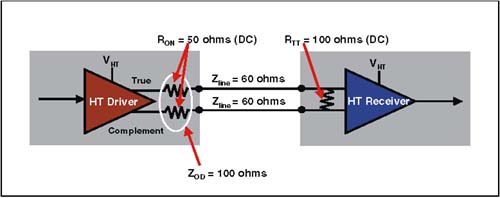 Table 14-3. DC Impedance Specification | Parameter | Min (Ohms) | Typical (Ohms) | Max (Ohms | | R TT | 90 | 100 | 110 | | R ON | 45 | 50 | 55 | | Delta R ON (true) | | | 5% | | Delta R ON (complement) | | | 5% | | Z OD | | 100 | | | Z line | | 60 | | Differential Output Voltage - DC The specification defines the DC differential output voltage under test load conditions for compliant operation. Each parameter is described below. Figure 14-4 on page 370 illustrates the output voltage parameters, along with the test load and test points for measuring the differential voltages specified. The voltage parameter values are listed in Table 14-4 on page 370. Note that the differential output voltage and the common-mode output voltage values happen to be the same, and is not an error in the table. -
V OD is the output differential voltage. It is the difference between the true signal voltage and the complement signal voltage with respect to ground (DO+)-(DO-). A Logic '0' is represented by a negative differential voltage and a Logic '1' is represented by a positive voltage difference under DC conditions. -
Delta-V OD is the change in voltage between the differential output voltage while driving a Logic '0' and while driving a Logic '1' (V OD_0 “ V OD_1 ). -
V OCM is the output common-mode voltage. This voltage is the average of the true signal voltage and the complement signal voltage with respect to ground under DC conditions (DO+)+(DO-)/2. This voltage is not directly measurable in an operational system, but can be derived from measuring the voltage of the true and complement voltages. However, by placing the driver in the ATE environment shown in Figure 14-4 the common mode voltage measurement can be made by hooking an oscilloscope at the VCM point. -
Delta-V OCM is the change in voltage between the common-mode output voltage while driving a Logic '0' and while driving a Logic '1' (V OCM_0 “ V OCM_1 ). Figure 14-4. DC Output Voltage Measurements 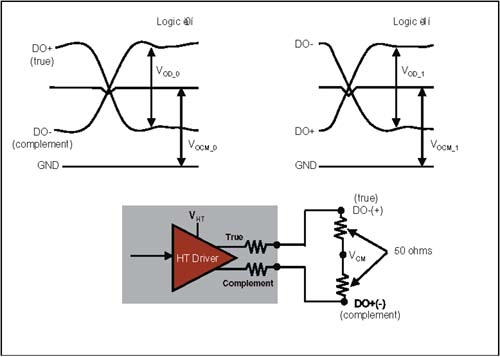 Table 14-4. Differential DC Output Voltages | Parameter | Min (mV) | Typical (mV) | Max (mV) | | V OD | 495 | 600 | 715 | | Delta-V OD | -15 | | 15 | | V OCM | 495 | 600 | 715 | | Delta-V OCM | -15 | | 15 | Differential Input Voltage - DC The DC differential Input Voltage parameters are illustrated in Figure 14-5. The input voltage parameters are defined below and the voltage values are listed in Table 14-5 on page 372. -
V ID is the input differential voltage at a receiver. It is the difference between the true signal voltage and the complement signal voltage with respect to ground measured at the input of a receiver. -
Delta-V ID is the change in voltage between the differential input voltage while receiving a Logic '0' and while driving a Logic '1' (V ID_0 “ V ID_1 ). -
V ICM is the input common-mode voltage. This voltage is the average of the true signal voltage and the complement signal voltage with respect to ground under DC conditions. -
Delta-V ICM is the change in voltage between the common-mode input voltage while receiving a Logic '0' and while driving a Logic '1' (V ICM_0 “ V ICM_1 ). Figure 14-5. Differential DC Input Voltage Parameters 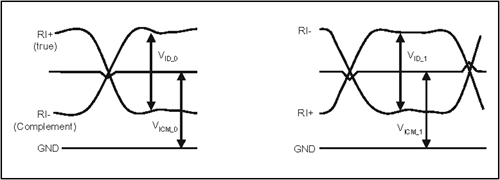 Table 14-5. Differential DC Input Voltages | Parameter | Min (mV) | Typical (mV) | Max (mV) | | V ID | 200 | 600 | 1000 | | Delta-V ID | -15 | | 15 | | V ICM | 440 | 600 | 780 | | Delta-V ICM | -15 | | 15 | Differential AC Characteristics The AC specifications are valid for a system working under normal operating conditions where signals are switching at that specified frequency and where noise is introduced due to crosstalk, reflections and inter-bit interference. A realistic system environment must be set up when performing device validation and characterization. Differential AC Impedance The AC impedance parameters are defined in the following bullet list and illustrated in Figure 14-6 on page 373 and the impedance parameter values are listed in Table 14-6 on page 373. Figure 14-6. AC Impedance Values  Definition of each impedance- related parameter is defined below: -
R TT ” the value of the differential input impedance of the receiver under AC conditions implemented with an on-die differential terminating resistor. Techniques used to compensate R TT for changes due to P, V, or T fluctuations can result in R TT having a non-linear I-V curve; therefore R TT is specified under AC conditions and should be characterized or guaranteed over all operating ranges of voltage, and temperature. -
R ON (pullup) ” the driver output impedance while driving high under AC conditions. This value and tolerance must be maintained from 0.5 * VLDT_nom to VLDT_nom. R ON (pulldown) is the driver output impedance while driving low under AC conditions. This value and tolerance must be maintained from 0V to 0.5 * VLDT. Techniques used to compensate the output driver for changes due to P, V, or T variations can result in the driver having a non-linear I-V curve; therefore RON is specified under AC conditions and should be characterized or guaranteed over all process, voltage, and temperature operating points. -
C OUT ” the driver output pad capacitance and is limited to act, along with the recommended transmitter package trace single-ended impedance of 35 “65 Ohms and maximum length of less than 850 mils, to create a matched impedance between the driver R ON and the characteristic impedance of the package trace. -
C IN ” the receiver input pad capacitance and is limited to act, along with the recommended receiver package trace single-ended impedance of 35 “65 Ohms and maximum length of less than 850 mils, to create a matched impedance between the interconnect transmission line and the characteristic impedance of the receiver package and input pad. Table 14-6. AC Impedance Specification | Parameter | Min (Ohms) | Typical (Ohms) | Max (Ohms | | R TT - Receiver input impedance | 90 | 100 | 110 | | R ON - Driver output impedance | 45 | 50 | 55 | | C out (operation at 800MHz and above) C out (operation below 800MHz) | | | 3pF 5pF | | C in (operation at 800MHz and above) C in (operation below 800MHz) | | | 2pF 5pF | Differential Output Voltage - AC The HT specification defines the output voltages of the driver under normal AC operating conditions. The output parameters are illustrated in Figure 14-7 on page 374. Compliant operation requires that the specified values be met when measured with the test load illustrated in Figure 14-8 on page 375. Table 14-7 on page 376 lists the specified output voltages. -
V OD ” the peak voltage difference between the true and complement signals (differential voltage) under AC conditions (RI+ “ RI “). -
Delta-V OD ” the change in magnitude between the output differential voltage while driving a logic 0 and while driving a logic 1 (V OD _0 “ V OD _1 ). -
V OCM ” the output common-mode voltage defined as the average of the true and the complement voltage with respect to ground under AC conditions. V ICM measures can be made at any moment in time and can fall at any point including crossover (RI+ + RI “) / 2. -
Delta-V OCM ” the peak change in magnitude between the output common-mode voltage while driving a logic 0 and while driving a logic 1. Delta-V OCM is equal to V OCM_1 “ V OCM_0. Figure 14-7. Differential AC Output Parameters  Figure 14-8. Test Setup for AC Output Voltage Measurements 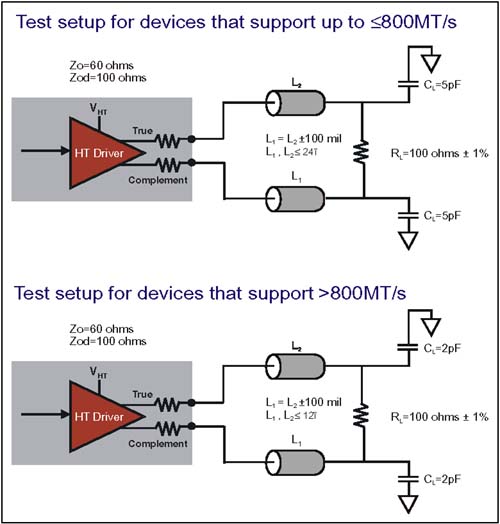 Table 14-7. AC Differential AC Output Voltages | Parameter | Min (mV) | Typical (mV) | Max (mV) | | V OD | 400 | 600 | 820 | | Delta-V OD | -75 | | 75 | | V OCM | 440 | 600 | 780 | | Delta-V OCM | -50 | | 50 | Differential Input Voltage - AC The AC differential Input Voltage parameters are defined below and illustrated in Figure 14-9. The voltage values are listed in Table 14-8 on page 377. -
V ID ” the peak voltage difference between the true and complement signals (differential voltage) under AC conditions (RI+ “ RI “). -
Delta-V ID ” the change in magnitude between the input differential voltage while receiving a logic 0 and while receiving a logic 1 (V ID _0 “ V ID _1 ). -
V ICM ” the input common-mode voltage defined as the average of the true and the complement voltage with respect to ground under AC conditions. V ICM measures can be made at any moment in time and can fall at any point including crossover (RI+ + RI “) / 2. -
Delta-V ICM ” the peak change in magnitude between the input common-mode voltage while driving a logic 0 and while driving a logic 1. Delta-V ICM is equal to V ICM_1 “ V ICM_0 . Figure 14-9. Input Voltage Parameters 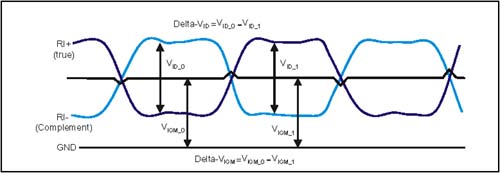 Table 14-8. Differential DC Input Voltages | Parameter | Min (mV) | Typical (mV) | Max (mV) | | V ID | 300 | 600 | 900 | | Delta-V ID | -75 | | 75 | | V ICM | 385 | 600 | 845 | | Delta-VICM | -100 | | 100 | Input Rising and Falling Edge Rates T R and T F are the rise and fall times respectively of the differential input signals. They are measured at +/-150mV point from the differential cross-over. Table 14-9 on page 378 lists the rising and falling edge rates. Note that the AC spec shows a greater range between minimum and maximum voltage parameters compared to the corresponding DC parameters. This is because the AC parameters include noise components . Table 14-9. Differential Input Edge Rate Parameters and Values | Parameter | Min (V/ns) | Max (V/ns) | | T R Input rising edge rate | 1.0 | 4.0 | | T F Input falling edge rate | 1.0 | 4.0 |  | 






